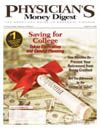Publication
Article
Physician's Money Digest
Time Marches On—Prevent Your Retirement from Being Crushed
Author(s):
You hear the phraseconstantly and even say it yourself.It might have been when you spent $50 at the gas pump, whenthe little house on your street sold for half a million dollars, orwhen an 8-year-old skipped by talking on a cell phone—timesare changing. And, unfortunately, the transformation of thecountry didn't sidestep retirement planning, yet much of ournation is reluctant to acknowledge that yesterday's ways ofsaving and investing just won't cut it today.
Today, more and more retirees are expecting to generate agreater income in retirement that exceeds the ability of theirportfolio of assets to support it. The expenses they will have tobear, which the previous generation was fortunate enough toavoid, are a greater burden than most portfolios can handle.
Unlike their parents, "the onus for saving for retirement ison the baby boomers," says David Legeay, senior vice presidentand director of portfolio management for InvestmentManagement Services at Key Private Bank. "And whereyou're used to having a pension and profit sharing, gettingthat annual, monthly, or weekly check from the company thatyou spent 40 years working for—having a comfortable andgood retirement—that just doesn't exist today."
According to the Congressional Budget Office (CBO), babyboomers have benefited from higher income during theirworking years than any preceding generation, and they havebeen accumulating substantial savings. But many researchersare concerned that their savings may not be adequate forretirement. The CBO found that only about half of boomerhouseholds are on track. Even though baby boomers are savingmore, they just aren't saving enough to make up the gapbetween higher expectations and the dwindling crutch ofemployer and government support.
"If you look at the landscape today," Legeay says, "almostthree quarters of the folks out there believe that they are goingto need 80% of their preretirement income in their retirementyears." Considering the higher consumption patterns and otherretirement costs like health care, Legeay says that is a prettyhigh expectation. "We found that about 70% of people haven'tachieved their ultimate goal of what they want to save forretirement, so it's a real challenge." So although more peopleare aware of the greater role they must play in their retirementplanning, their saving and investing still does not meet therequirements for a comfortable retirement for today's retiree.
Along with the decreasing support from traditionalsources, retirees must juggle two additional variables thatprevious generations did not—longer life expectancy and theincreased cost of health care—and these variables must beweaved into their retirement plan equation. "The babyboomers today are expected to live a whole lot longer thantheir parents ever did," Legeay says. He compares the life expectanciestoday to those in 1950, saying that the chance ofliving to age 70 is more than 50% greater today, the chanceof living to age 80 is almost double today, and the chance ofliving to age 90 is over double today than what it was backin 1950. "So the fact that people are living longer puts morestrain on retirement savings than it ever has before."
Another part of the equation is theever-growing thorn in the side of ourcountry: health care. The ability ofcompanies to take care of their longtimeemployees with health insuranceafter they retire follows the pattern ofpensions and profit sharing plans—these programs are disappearing. Accordingto the 2005 MetLife MarketSurvey, a nursing home in the UnitedStates costs an average of $203 per day,roughly $74,000 per year. And accordingto Americans for Long Term CareSecurity, more than half of the US populationwill require some type of long-termcare during their lives.
"So you combine longer living withhigh health-related costs, and you cansee where the expectations of what youwill need to spend in retirement aremuch greater today than they were 50years ago," Legeay says. The followingare some methods physicians can use totry to meet the retirement savings expectationsthat today's retiree must bear.
•Savings and portfolios. When itcomes to money, it's simple—people justneed to save more. "People need to putmore away, knowing they have to takemore responsibility and more ownershipfor how they're going to retire, and howthey're going to fund that retirement," Legeay says. "And you'd have to managethe expectations down, or you'dhave to take greater risk within the portfolioof assets to grow those assets atsuch a rate that ultimately, you're goingto get to your end goal." But, of course,with risk you chance great losses.
•Obtain long-term care. Theresponsibility of health care is beingshifted to today's retiree, and the majorityof people will require some stay in anassisted living facility or some longerterm care facility—a costly expense.Long-term care insurance is one way todefray some of those costs. "If you buyit today, it's a heck of a lot cheaper thanif you wait 20 years from today to buyit," Legeay says.
•Invest in commercial real estate.Physicians today are more entrepreneurialthan ever. "Many physicianspractice out of one office suite within alarger building. But what we're seeing isa trend where physicians actually ownthe building," Legeay says. "So thosecommercial real estate ventures andcommercial real estate properties areactually starting to pay them a steadyincome stream in retirement."
•Team up with other physicians.The private practitioner today existsmuch differently than years ago. Manyphysicians will form four-or five-personpractices, enabling them to set up moreefficient retirement planning and healthinsurance, while lowering occupancy expenses."Relatively independent physiciansare banning together to form whatends up being a loose partnership, wherethey can still operate somewhat independentlyand on their own schedulesand own time," Legeay says. "And yetthey will still receive the benefits of beingable to partner as it relates to some of theexpenses associated with the practice."
The increasing financial responsibilitiesof today's retirees are not reflectedin savings. "The disconnect betweenwhat people actually have and the realitiesof what they're going to need ispretty phenomenal at all levels," Legeaysays. "People just aren't aware; theydon't pay attention. They just live fortoday and not for the future." And thatis a gamble that is more risky than anyinvestment.
